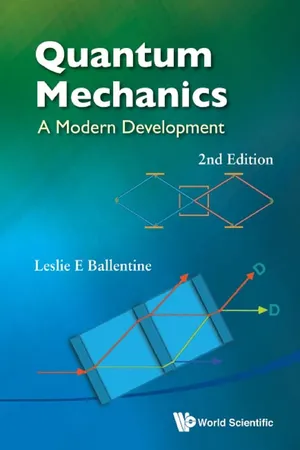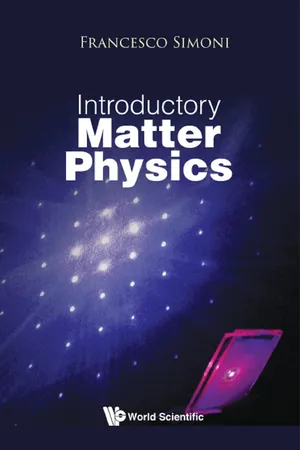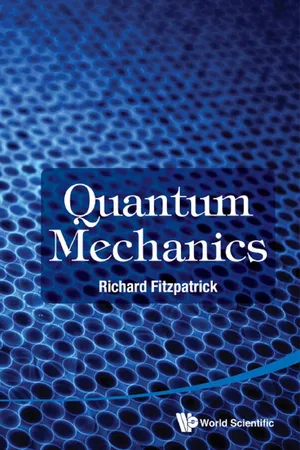Physics
Ehrenfest Theorem
The Ehrenfest theorem is a fundamental concept in quantum mechanics that relates the time evolution of a quantum system to its classical counterpart. It states that the rate of change of the expectation value of a quantum mechanical operator is equal to the expectation value of the commutator of the operator with the Hamiltonian.
Written by Perlego with AI-assistance
Related key terms
Related key terms
1 of 4
Related key terms
1 of 3
3 Key excerpts on "Ehrenfest Theorem"
- eBook - ePub
Quantum Mechanics
A Modern Development
- Leslie E Ballentine(Author)
- 2014(Publication Date)
- WSPC(Publisher)
neither necessary nor sufficient to define the classical regime (Ballentine, Yang, and Zibin, 1994). Lack of sufficiency — that a system may obey Ehrenfest’s theorem but not behave classically — is proved by the example of the harmonic oscillator. It satisfies (14.6) exactly for all states. Yet a quantum oscillator has discrete energy levels, which make its thermodynamic properties quite different from those of the classical oscillator. Lack of necessity — that a system may behave classically even when Ehrenfest’s theorem does not apply — will be demonstrated below.Corrections to Ehrenfest’s theorem
Let us introduce operators for the deviations from the mean values of position and momentum, and expand (14.1) and (14.2) in powers of these deviation operators. Taking the average in some chosen state then recovers (14.3), and yields, in place of (14.4),where the average position and momentum are q 0 = 〈Q 〉 and p 0 = 〈P 〉. If 〈(δQ )2 〉 and higher order terms are negligible, we recover Ehrenfest’s theorem, with q 0 and p 0 obeying the classical equations.The terms in (14.9) beyond F (q 0 ) are corrections to Ehrenfest’s theorem. But they are not essentially quantum-mechanical in origin, as is evidenced by the fact that they do not depend explicitly on ħ . Indeed, 〈(δQ )2 〉 is just a measure of the width of the position probability distribution, which need not vanish in the classical limit. The proper interpretation of these correction terms can be found by comparison with a suitable classical ensemble.LetFrom it, we can calculate the classical averages,ρc(q , p , t ) be the probability distribution in phase space for a classical ensemble. It satisfies the Liouville equation, which describes the flow of probability in phase space,Differentiating these expressions with respect to t , using (14.10), and integrating by parts as needed, we obtainwhich are the classical analogs of (14.3) and (14.4). Expanding (14.14) in powers of δq =q − qc - eBook - ePub
- Francesco Simoni(Author)
- 2018(Publication Date)
- WSPC(Publisher)
principle of correspondence. It also guarantees that the same conservation laws can be applied to quantum-mechanical systems. It means that the results of analysis coming from the statistical approach of quantum mechanics correspond to those of the deterministic approach of classical mechanics when measurement is based on a high number of single events.The mathematical demonstration of this principle is given by Ehrenfest’s theorem. We will first give the demonstration of Eq. (2.75), showing that for each component of the velocity the expectation value is the time derivative of the corresponding position coordinate, and getTherefore, we can apply to expectation values the usual definition of velocity used in classical mechanics:Let us do the calculation for the x component,taking into account that inside the integral x appears as a time-independent operator. From the Schrödinger equation,ThenThe ∇2 operator is self-adjoint:Then On the other hand, Therefore, which coincides with the first of Eqs. (2.93)Another fundamental equation is the second law of classical dynamics, F = ma, orwhich we can demonstrate to be fulfilled by the expectation values of the corresponding physical quantities. This can be done by using Eq. (2.91) to calculate the time derivative of the linear momentum p.According to Eq. (2.91), we writeTherefore, we getSince px is not explicitly dependent on t,Then On the other hand, since the derivation order is not relevant. As a consequence, i.e. This calculation can be repeated for the other components to giveThis is a very important result of the theory, since it gives the link between the microscopic statistical approach of quantum mechanics and the macroscopic deterministic approach of Newtonian mechanics.2.6. Eigenfunctions and eigenvalues
Looking at the Schrödinger equation independent of time (2.57),on the left we have the Hamiltonian operator applied to the wave function ϕ(r) and on the right a number E which corresponds to the total energy of the system described by ϕ(r) multiplied by the same wave function. In other words, we can say that the result of applying to ϕ(r) is the value of energy times ϕ(r). In such a case, we call all the functions ϕ(r) fulfilling this equation eigenfunctions of and we call eigenvalues the corresponding values of E - eBook - ePub
- Richard Fitzpatrick(Author)
- 2015(Publication Date)
- WSPC(Publisher)
υ . Heisenberg’s equation of motion yieldsThus, any observable that commutes with the Hamiltonian is a constant of the motion (hence, it is represented by the same fixed operator in both the Schrödinger and Heisenberg pictures). Only those observables that do not commute with the Hamiltonian evolve in time in the Heisenberg picture.3.4Ehrenfest Theorem
We have now introduced all of the basic elements of quantum mechanics. The only element that is lacking is some rule to determine the form of the quantum mechanical Hamiltonian. For a physical system that possess a classical analog, we generally assume that the Hamiltonian has the same form as in classical physics (i.e., we replace the classical coordinates and conjugate momenta by the corresponding quantum mechanical operators). This scheme guarantees that quantum mechanics yields the correct classical equations of motion in the classical limit. Whenever an ambiguity arises because of non-commuting observables, this can usually be resolved by requiring the Hamiltonian H to be an Hermitian operator. For instance, we would write the quantum mechanical analog of the classical productx px, appearing in the Hamiltonian, as the Hermitian product (1/2)(x px+px x). When the system in question has no classical analog then we are reduced to guessing a form for H that reproduces the observed behavior of the system.Consider a three-dimensional system characterized by three independent Cartesian position coordinatesxi(where i runs from 1 to 3), with three corresponding conjugate momentapi. These are represented by three commuting position operatorsxi, and three commuting momentum operatorspi, respectively. The commutation relations satisfied by the position and momentum operators are[See Equation (2.25).] It is helpful to denote (x 1 , x 2 , x 3 ) as x and (p 1 , p 2 , p 3 ) as p
Index pages curate the most relevant extracts from our library of academic textbooks. They’ve been created using an in-house natural language model (NLM), each adding context and meaning to key research topics.
Explore more topic indexes
Explore more topic indexes
1 of 6
Explore more topic indexes
1 of 4


